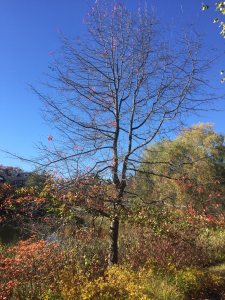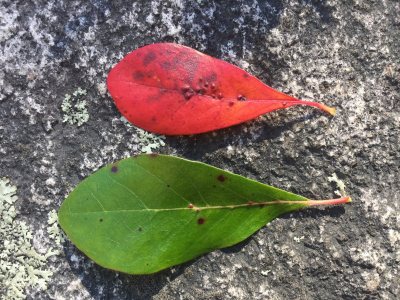Tupelo
Nyssa sylvatica | Family: Cornaceae
Submission: Samantha Pierce ‘19
Natural History:
 Nyssa sylvatica, also known as the black tupelo, got its common name from the Creek Indian word for swamp. Fittingly, the black tupelo grows best in wetlands throughout the Eastern United States. It is rarely found in the far north, but grows as far south as Florida. It is found in a range of wetland sites, such as swamps, stream beds, and alongside lakes, ponds, and rivers; sometimes even on dry uplands where it grows at a slower rate. This intolerant tree often reaches 30-50 feet in height with a straight trunk and a full, rounded crown of obovate leaves. Its leaves can be easily spotted in the fall when they turn a bright red color. For this reason, the black tupelo is often planted as an ornamental tree to brighten outdoor spaces in the fall.
Nyssa sylvatica, also known as the black tupelo, got its common name from the Creek Indian word for swamp. Fittingly, the black tupelo grows best in wetlands throughout the Eastern United States. It is rarely found in the far north, but grows as far south as Florida. It is found in a range of wetland sites, such as swamps, stream beds, and alongside lakes, ponds, and rivers; sometimes even on dry uplands where it grows at a slower rate. This intolerant tree often reaches 30-50 feet in height with a straight trunk and a full, rounded crown of obovate leaves. Its leaves can be easily spotted in the fall when they turn a bright red color. For this reason, the black tupelo is often planted as an ornamental tree to brighten outdoor spaces in the fall.
Black tupelo has a variety of uses beyond its aesthetic beauty. Its greenish-white flowers are rather common in appearance, unless you are a bee; then they are a wonderful source of nectar used to make honey. White-tailed deer enjoy gnawing on the protein and fiber-dense young tree sprouts and branches. As the tree ages, however, it loses palatability. When planted as an ornamental tree, it should be well guarded against herbivores to ensure that it matures past its edible phase. The fruit of black tupelo are nutrient-rich, clusters of berry-like drupes. A variety of birds and mammals eat the fruit, ensuring the black tupelo a wide range of seed dispersal.
Tupelo wood is commonly used as a veneer to coat boxes, crates, baskets, furniture, and interior woodwork. The wood is very knotted with an irregular grain, rendering it unsuitable for splitting into timber. However, black tupelo wood is very tough, making it ideal for the handles for hammers, chisels, and other tools. It is also used as gunstocks, pistol grips, blocks, flooring, and rollers in glass factories. Because of its intricate grain, the wood is also used to make carved bowls, spoons, and ornaments.
Identification:

Leaves – 5”, entire (occasionally toothed), obovate, lustrous, with scarlet fall color.
Twigs – Slender, with numerous spur shoots; buds ovoid, imbricate, commonly divergent.
Fruit – Cluster of dark blue ½” drupes, pit distinctly ribbed.
Bark – Thick, reddish-brown, with distinct square blocks (looks like alligator hide).
References:
Brockman, C.F. 1986. Trees of North America: A Guide to Field Identification. Revised Edition. Western Pub. Co., Inc. 280pp.
Coladonato, Milo 1992. Nyssa sylvatica In: Fire Effects Information System, [Online].
U.S. Department of Agriculture, Forest Service, Rocky Mountain Research Station, Fire Sciences Laboratory. Web. Oct. 28, 2017, from https://www.fs.fed.us/database/feis/plants/tree/nyssyl/all.html
Elias, T.S. 1980. The Complete Trees of North America Field Guide and Natural History. Van Nostrand Reinhold Co., N.Y. 948pp.
Harlow, W.M., Harrar, E.S., Hardin, J.W. and White, F.M. 1991. Textbook of Dendrology. McGraw-Hill Inc., N.Y. 501pp.
Petrides, G.A. 1972. A Field Guide to Trees and Shrubs. 2nd edition. Houghton Mifflin Co., Boston. 428pp.
Preston, R.J., Jr. 1989. North American Trees. 4th edition. Iowa State Univ. Press. Ames. 407pp.
Nyssa Sylvatica. Missouri Botanical Garden. Web. Oct. 28, 2017, from http://www.missouribotanicalgarden.org/PlantFinder/PlantFinderDetails.aspx?kempercode=a670
Nyssa Sylvatica: Black-gum, Black Tupelo. Go Botany. Web. Oct. 28, 2017, from https://gobotany.newenglandwild.org/species/nyssa/sylvatia